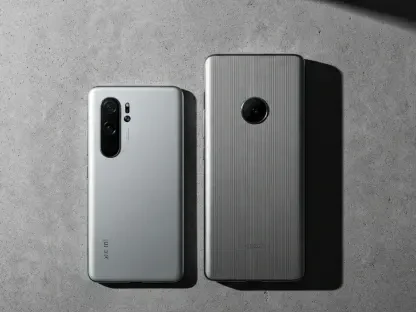Imagine stepping into a bustling city commute, craving an affordable pair of earbuds that can drown out the noise without draining your wallet, and finding the perfect solution in the Google Pixel Buds 2a. Unveiled on August 20, these earbuds emerge as a promising option for budget-conscious audio enthusiasts with an estimated price of $150. This roundup gathers insights, opinions, and analyses from various industry voices and tech communities to unpack what makes the Pixel Buds 2a a standout choice in a crowded market. The goal is to provide a balanced perspective on whether these earbuds truly deliver value or fall short of expectations.
Diving into Design: Cost-Saving or Compromise?
Tech observers across multiple platforms have noted the Pixel Buds 2a’s design as a deliberate blend of inspiration and restraint. Drawing from the flagship Pixel Buds Pro 2, the earbuds feature smaller wingtips compared to the A-Series, aiming for a snugger fit. The charging case, available only in white, mirrors the Pro’s aesthetic, while the earbuds come in gray and iris shades, with unconfirmed whispers of Fog Light and Hazel options floating in discussion forums.
However, not all feedback is glowing. Some online tech communities have pointed out cost-cutting measures, such as a printed “G” logo instead of an embossed one, alongside tweaks like new microphone grilles and repositioned sensors. These changes, while subtle, have led to debates about whether they cheapen the overall look or smartly prioritize function over flair.
A recurring theme among design critiques is the limited color palette. While some enthusiasts appreciate the minimalist approach, others argue that restricting case colors to white might alienate buyers seeking personalization. This split in opinion highlights a broader question: does trimming aesthetic variety undermine perceived value, or does it keep the focus on affordability?
Feature Highlights: Impressive Upgrades or Bare Minimum?
Active Noise Cancellation and Spatial Audio: A Budget Win?
One of the most discussed aspects of the Pixel Buds 2a is the inclusion of Active Noise Cancellation (ANC) and Spatial Audio—features often reserved for pricier models. Tech blogs widely praise this move, noting that even a basic version of ANC could transform daily experiences like commuting or casual listening. Many see this as Google’s attempt to democratize modern audio tech for a wider audience.
Yet, there’s a flip side. Some industry watchers caution that these features lack the sophistication of the Pro series, missing advanced elements like adaptive Silent Seal or head-tracking for Spatial Audio. This has sparked mixed reactions, with casual users likely satisfied, while audiophiles might find the stripped-down tech underwhelming for immersive needs.
Discussions also center on real-world utility. Community feedback suggests that for the estimated $150 price, these additions are a steal for anyone prioritizing noise reduction over premium soundscapes. The consensus leans toward viewing these features as a significant step up from the A-Series, though expectations must be tempered against flagship benchmarks.
Battery Life and Charging: A Necessary Trade-Off?
Battery performance is another hot topic, with leaked specs indicating reduced endurance and no wireless charging to maintain the budget price point. Many tech reviewers argue this aligns with trends in affordable earbuds, where longevity often takes a backseat to cost. For casual listeners, this might not pose a major hurdle, especially if daily use doesn’t demand extended playtime.
Contrasting views emerge from user forums, where some express frustration over the compromise. They contend that in a market increasingly valuing all-day battery life, this cutback could deter buyers who multitask or travel frequently. The debate often hinges on regional expectations, with some noting that American consumers might be more forgiving given the price.
A balanced perspective from tech analysis platforms suggests that while the shorter battery life is a clear drawback, it’s not a dealbreaker for everyone. The key takeaway is that potential buyers must weigh their usage patterns against the savings, a point echoed across multiple discussions as a practical lens for evaluating this trade-off.
Fitting into Google’s Lineup: A Strategic Middle Ground?
Positioning the Pixel Buds 2a as a mid-tier option between the basic A-Series and the premium Pro models has garnered attention from market analysts. Many agree that this fills a crucial gap, targeting consumers who want more than entry-level but can’t justify flagship costs. This strategic placement is often cited as a smart move to capture a broader demographic.
Comparisons to competitors in the budget space reveal varied opinions. Some industry voices argue that Google’s blend of features like ANC at this price could pressure rivals to up their game, potentially reshaping value expectations. Others, however, question if the compromises in battery and advanced tech might allow competitors to edge ahead with more robust offerings.
A deeper dive into online tech panels reveals speculation on long-term impact. There’s a growing belief that this middle-ground approach might inspire Google to refine future budget products with even bolder features. This positioning, while divisive, is largely seen as a calculated step toward redefining affordability in wireless audio.
Practical Insights from the Community for Potential Buyers
Synthesizing the chatter, the Pixel Buds 2a emerge as a compelling pick for those seeking Pro-inspired design and essential upgrades like ANC at a competitive $150. User tips often revolve around assessing personal needs—those prioritizing cost over battery endurance might find these earbuds ideal for everyday scenarios like short commutes or workouts.
Another recurring piece of advice is to monitor the official launch aftermath on August 20 and the delayed availability until October 9. Tech enthusiasts recommend keeping an eye on early user feedback post-release to gauge real-world performance, especially regarding fit and noise cancellation effectiveness in varied environments.
Lastly, community discussions emphasize comparing the 2a against alternatives in the same price bracket. Many suggest that for buyers hesitant about trade-offs like no wireless charging, exploring other brands might be wise. This collective wisdom underscores the importance of aligning purchase decisions with specific lifestyle demands.
Reflecting on a Pivotal Release in Audio Accessibility
Looking back, the unveiling of the Google Pixel Buds 2a on August 20 sparked a meaningful dialogue about balancing affordability with innovation in the audio market. The diverse opinions gathered highlighted both the earbuds’ potential to redefine budget tech and the challenges of meeting varied consumer expectations. Moving forward, potential buyers are encouraged to delve into early reviews after the October 9 availability date to validate leaked specs against actual performance. Additionally, keeping tabs on how Google evolves its mid-tier strategy could offer clues about future value-driven releases. This release served as a reminder that accessible technology can still push boundaries, paving the way for more inclusive audio solutions down the line.









